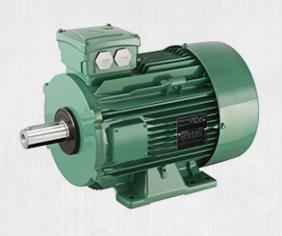
3 minute read
Image 21: Picture of an induction motor for illustration purpose
of hours the leaks occur, the boiler’s operating pressure and the enthalpies of the steam and boiler feed water (where enthalpy is a measure of the energy content of the steam and feed water).
Motors
Advertisement
Electric motors are used to provide motive power to equipment such as processing equipment, air compressors, pumps, blowers, etc. It is important that industrial enterprises accurately define their processing needs to enable proper selection of a motor for a particular application. Some best practices for saving energy in motors are given below:
• Make a list of all existing motors used in the enterprise. Note down the motors’ parameters, including rated power, hours of operation, age of each motor and efficiency class.
• Using a clamp-on meter, measure each motor’s actual load to identify the percentage of actual power as compared to rated power.
• Select the appropriate size of motor for more efficient operations. Motors should be sized to operate within a load window of 65 to 100 percent of their rated load.35 However, the common practice of motor over-sizing results in less efficient operation. For example, an over-sized motor operating at a 35 percent load is less efficient than a smaller motor that would operate between 65 and 100 percent with the same load.
• It is a common practice for enterprises to rewind a motor when it burns out due to electrical failures, disruption to power supply or insulation breakdown. Such failures are typically caused by contaminants, abrasion, vibration or voltage surges. However, rewinding reduces motor efficiency by 1 to 3 percent.
36 Therefore, rewinding a motor more than three times in the lifetime of the motor is not cost efficient, regardless of the type or size of motor or the context. Given
Image 21: Picture of an induction motor for illustration purpose
35 Government of India. India Guide Books. Bureau of Energy Efficiency (BEE). LINK. 36 Government of India. India Guidebooks. Bureau of Energy Efficiency (BEE). LINK.
the increased energy inefficiency of a rewound motor, purchasing a new motor provides more cost savings in the long term.
• Install Variable Frequency Drives (VFDs) on valve-controlled fans and pumps that operate in a range of conditions. To know the exact economic benefits of installing VFDs, information on the frequency of an enterprise’s fan and pump operations is necessary. As a rule of thumb, a VFD-supplied air flow of 50 percent reduces electricity consumption by 70 percent as compared to controlling air flow with a valve.37
• Use an energy-efficient V-belt. V-belts have a trapezoidal cross section that create a wedging action on pulleys within a motor to increase friction and power transfer capacity. V-belt drives can reach a nominal efficiency of 93 percent.
38 Regularly check the tension of the belts to maintain efficiency.
Refrigeration and air conditioning
Refrigeration is the process of removing heat at a low temperature level and rejecting it at a relatively higher temperature level. Refrigeration, including equipment for freezing to temperatures below 0 degrees Celsius, and/or air conditioning is accomplished by various methods, such as through a vapor compression system, absorption system, or steam-jet refrigeration cycle. Based on the experience of SUSTENT Consulting, the most used refrigeration systems are vapor compression, followed by absorption. The means of achieving higher energy efficiency in both refrigeration and air conditioning systems are similar, hence the opportunities for energy efficiency in these systems are presented together.
The required elements making up a complete refrigeration and air-conditioning system are refrigerating equipment (such as mechanical compression refrigeration, evaporative cooling, absorption refrigeration, vapour compression refrigeration or vapour absorption refrigeration), fans, pumps, cooling towers, filters, air-handling units, and ducting. Depending on the process, all or some of the equipment mentioned may be required. Some best practices for saving energy in refrigeration and/or air conditioning systems are given below:
• Mount blinds outside windows in addition to inside to prevent warming.
• Turn off unused devices, as they produce additional heat.
• Close doors in air-conditioned rooms and cold storage units.
• Turn off air conditioning when no cold air is needed.
• If possible, increase an air conditioner’s temperature to 25 degrees Celsius, and no lower; every increased degree of room temperature saves up to 6 percent of air conditioning-related electricity39
37 Government of India. India Guidebook. Bureau of Energy Efficiency. LINK. 38 Grainger. Types of Belt Drives and How They Improve Efficiency. LINK. 39 Wibberly, Alana. 2016. What’s the Best Temperature for my Thermostat? SmartEnergy. LINK.









